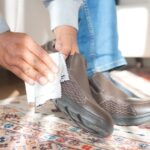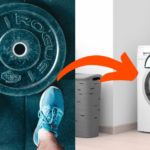While suede is a great alternative to traditional leather, it requires a completely different cleaning method.
Considering suede can pick up marks and stains more easily than leather, knowing a proper cleaning method is a must.
In this article, you’ll learn how to clean suede shoes using both specialised products and things you probably already have at home.
What Is Suede?
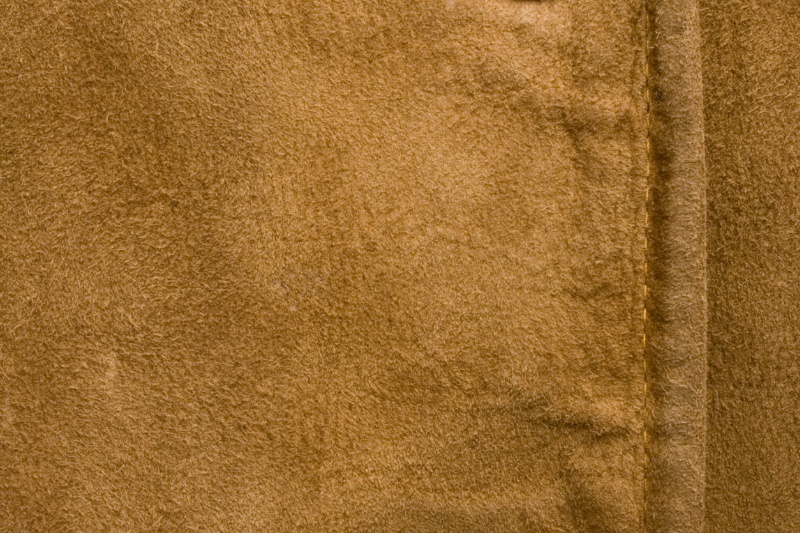
To understand how to clean suede, we should first discuss what it actually is and how it differs from leather. So, what is suede?
Suede is essentially the other side of a piece of leather. Traditional leather shoes are made from the outer side of a skin, whereas suede is the inner layer. It has a soft, fuzzy finish that’s called the nap.
The characteristics of suede are:
- Soft, fuzzy finish
- Thinner than leather
- More flexible (easier to break in and more comfortable)
- Less durability than leather
Its texture means it can stain and mark more easily because it’s essentially more like fabric than normal leather.
The nap can absorb moisture and pigments, leading to stains. But it retains the characteristic of leather that it doesn’t take too well to water.
How to Clean Suede Shoes
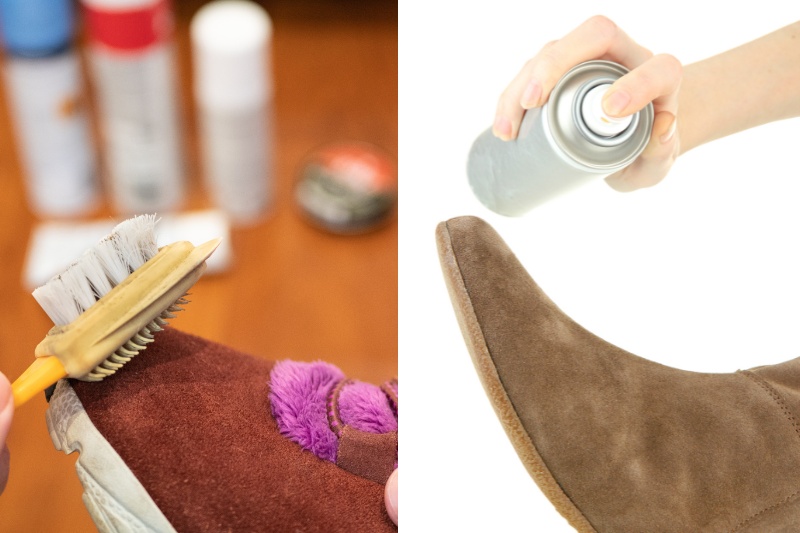
Cleaning suede isn’t difficult, provided you’ve got the right products.
You can use liquid-based products to clean suede shoes, but it’s best to use something with a low evaporation point. Depending on what you have to hand, some of the best products include:
- White vinegar
- Rubbing alcohol (isopropyl alcohol)
- Suede shampoo or cleaner like Kiwi Suede & Nubuck Quick Dry Cleaner
The steps for cleaning suede are as follows:
- Start by removing dry dirt with a stiff brush. You can buy dedicated suede brushes but a toothbrush, household brush or metal-bristled brush will work fine.
- If possible, brush your suede shoes in the same direction (such as front to back). This will minimise damage to the nap.
- Pour a small amount of white vinegar or rubbing alcohol onto a clean cloth and rub the stains. Try not to rub too hard, as you could damage the suede.
- Once the product has dried, use a softer brush to restore the nap.
- Finally, use a protector spray like Kaps Nano Protector if you want to give your shoes some stain resistance for the future.
If you’re using suede shampoo, simply follow the instructions on the product. It usually involves spraying it on, leaving it, and then wiping it away. But the method above will work just as well if you don’t want to buy a new product.
Also, for superficial stains, you can try using a pencil eraser. Erasers are gentle enough to pull out minor stains without causing any damage to the suede.
How Often to Clean Suede Shoes
Depending on how often you wear your suede shoes, you should be cleaning them once a month or so.
This doesn’t mean giving them a deep clean with vinegar or rubbing alcohol. It involves just giving them a quick brush over to remove dried-on dirt and keep the nap fresh.
Make sure you reapply protector spray every time, as it’ll make cleaning your suede shoes much easier.
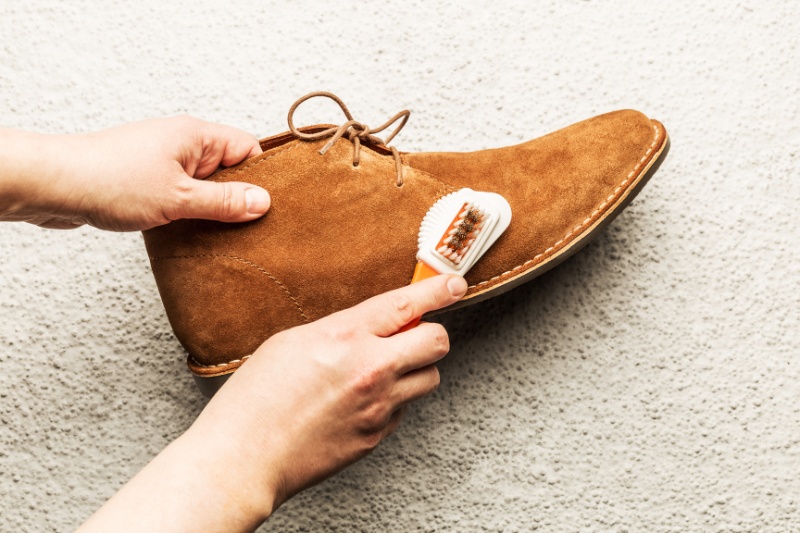
Is It OK to Clean Suede with Water?
It is OK to use water to clean suede, but you need to be very careful and sparing with the amount you use.
You shouldn’t put suede shoes or trainers in the washing machine.
There are products that do a better job than water for suede cleaning, so you might as well avoid it altogether. It’s fine to use water-based liquids (like white vinegar) because you won’t use much of them.
Why shouldn’t you use water to clean suede shoes? It’s pretty simple: suede absorbs water.
As it dries, the suede goes stiff and can even become brittle. The best comparison is what happens to your skin if you wash it but don’t moisturise after. It dries out and loses elasticity. And, after all, suede is made from skin.
You shouldn’t need to apply dedicated moisturiser to suede shoes, though. Cleaning them regularly and using protector spray will keep water out, so the suede should stay supple and healthy without any further intervention. Applying products like leather cream can ruin the nap because it isn’t absorbed in the same way as with normal leather.
How to Restore Bald Suede
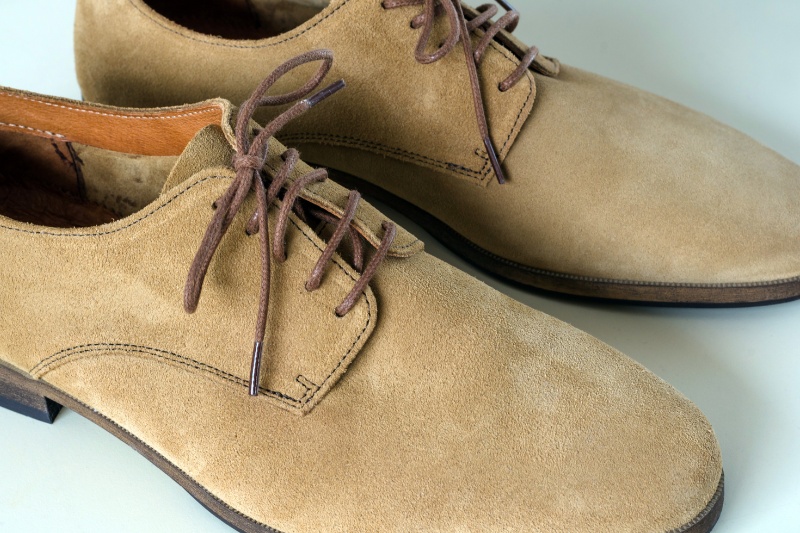
As part of your suede cleaning process, you might notice that your shoes have bald spots. This is pretty common on the toes or the heels depending on how you walk and put the shoes on.
Bald spots happen when the nap wears down or flattens and ends up looking like leather.
Depending on the suede’s colour, bald spots can be quite obvious. Luckily, it’s not a difficult problem to solve, as long as the spot isn’t too discoloured. Restoring bald suede basically involves lifting it or recolouring it.
A couple of options to try include:
Sandpaper
Using fine-grit sandpaper, rub the bald spot very lightly. This essentially creates new nap and makes the bald spot less obvious.
Of course, it won’t look exactly like the original suede, but it should hide fairly well on darker colours. Just don’t rub too hard because you don’t want to remove too much of the material.
Spray paint
Plenty of companies sell suede restorer spray. It’s essentially spray paint. Colour matching can be difficult, but it’s one of the most effective ways to hide a discoloured bald spot.
Steam
To go against earlier advice, you can use steam to lift the nap in bald areas. It’s easiest to use an iron, but a kettle will also work (just be careful because steam is obviously hot).
Hold your suede shoe over steam for a few minutes, and then go over the area with a metal-bristled brush. Try not to saturate the area with water. If you do, use a cloth to dab off excess water.
Final Thoughts on Cleaning Suede Shoes

Cleaning suede shoes is pretty straightforward once you know how to treat it. In some ways, it acts just like normal leather, but in others, it works more like fabric.
As long as you’re gentle with the nap and don’t use too much water, you can’t go too wrong with cleaning suede.

Jacob is a writer based in Wales, where he lives with his partner and two dogs. All his work is fuelled by extensive research and buckets of coffee.




